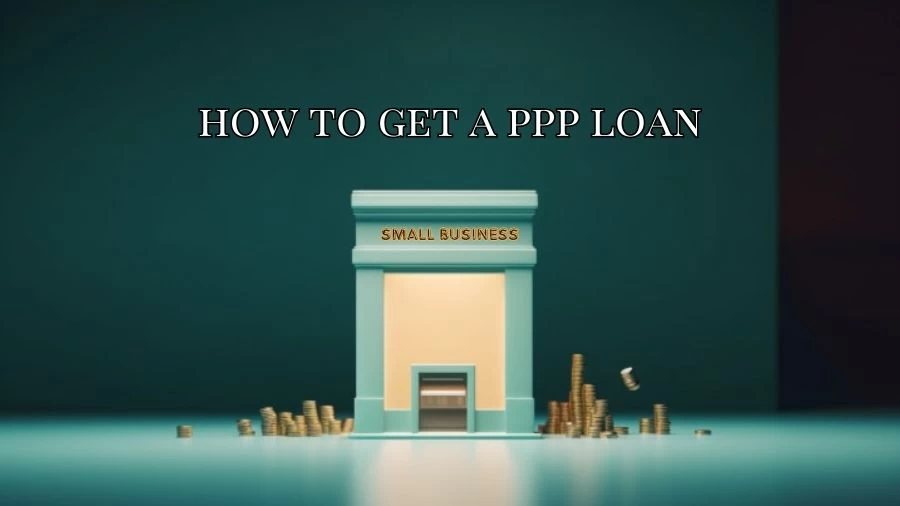
How to Get a PPP Loan? Who is Not Eligible for PPP Loan?
Obtain a PPP loan by verifying eligibility, gathering required documents, applying through a participating lender, awaiting approval, and using funds for approved expenses while maintaining accurate records.
by Kowsalya
Updated Aug 23, 2023
On This Page
How to Get a PPP Loan?
Here's a step-by-step procedure on how to get a PPP loan:
Step 1: Determine Eligibility
- Ensure that your business meets the eligibility criteria for a PPP loan. This includes having 500 or fewer employees (or meeting the SBA's industry-specific size standards), being in operation before February 15, 2020, and being able to demonstrate a need for the loan due to the impact of the COVID-19 pandemic.
Step 2: Gather Documentation
- Collect the necessary documentation to support your application. This may include payroll records, tax documents, financial statements, and other relevant financial information. These documents will help verify your eligibility and determine your loan amount.
Step 3: Find a Participating Lender
- Identify a lender that participates in the PPP program. This could be a bank, credit union, or an online lender. Check with multiple lenders to compare terms and requirements.
Step 4: Complete the Application
- Obtain the PPP loan application form from your chosen lender or the SBA's official website. Complete all required sections of the application accurately and thoroughly. Provide details about your business, ownership, and how you plan to use the loan funds.
Step 5: Calculate Loan Amount
- Calculate the maximum loan amount you're eligible for based on your average monthly payroll costs. For most businesses, this includes wages, salaries, tips, benefits, and taxes, up to a certain cap.
Step 6: Submit Application and Documentation
- Submit your completed PPP loan application along with the required documentation to your lender. Make sure to include all necessary paperwork to support your application and validate the loan amount you're requesting.
Step 7: Wait for Review and Approval
- Your lender will review your application and documentation. They may request additional information or clarification if needed. Be patient during this process, as the lender needs to ensure the accuracy and eligibility of your application.
Step 8: Loan Offer and Acceptance
- If your application is approved, you'll receive a loan offer detailing the loan amount, interest rate, terms, and conditions. Review the offer carefully and accept it if you agree with the terms.
Step 9: Loan Disbursement
- Once you accept the loan offer, your lender will provide you with instructions on how to receive the loan funds. The funds will typically be disbursed directly to your business bank account.
Step 10: Use of Funds
- Use the PPP loan funds for eligible purposes, primarily payroll costs (at least 60% of the total amount) and other allowable expenses such as rent, utilities, and certain operational expenses.
Step 11: Loan Forgiveness Application
- After the funds are used, you can apply for loan forgiveness. Complete the PPP Loan Forgiveness Application, providing detailed documentation on how you used the funds during the covered period.
Step 12: Maintain Records
- Keep thorough and accurate records of how you spent the loan funds, as well as any other relevant financial information. These records will be crucial when applying for loan forgiveness.
Step 13: Loan Repayment (if applicable)
- If any portion of the loan is not forgiven, you will need to repay it according to the terms outlined in your loan agreement.
Step 14: Stay Informed
- Keep up-to-date with any changes or updates to the PPP program through official sources like the SBA's website or your lender's communications.
Remember that the specific details and requirements of the PPP loan process may change based on government regulations and updates. It's recommended to consult with financial advisors or legal experts to ensure you're following the latest guidelines accurately.
Who is Not Eligible for PPP Loan?
The new round of Paycheck Protection Program (PPP) loans has expanded eligibility to a broader range of borrowers, particularly targeting those who were in business as of February 15, 2020. This update encompasses various business types and entities. Notably, news outlets with up to 500 employees per location can now access these loans. Additionally, 501(c)(6) nonprofits and destination marketing organizations may qualify, provided they adhere to size and lobbying limitations.
This round of PPP loans extends its reach to include sole proprietors, self-employed individuals, independent contractors, and those engaged in side gig work. Notably, publicly traded companies are excluded from participating in this latest phase of the PPP.
Specific provisions within this round of PPP funding are dedicated to aiding vulnerable sectors:
- Grants for Cultural and Entertainment Institutions: Organizations within the live entertainment, museum, and movie theater industries that have experienced a 25% reduction in revenues can apply for grants. It's important to note that recipients of these grants are not eligible to receive PPP loans simultaneously.
- Community Financial Institutions: Loans distributed through community financial institutions and select small depository institutions are part of this initiative. This targeted approach aims to reach underserved communities.
- Support for Smaller Businesses: A portion of the funding is allocated to businesses with 10 or fewer employees. Furthermore, loans under $250,000 are designated for low-income areas, offering critical financial assistance where it's most needed.
In an update announced on February 22, 2021, certain restrictions have been lifted, expanding the pool of eligible applicants. Business owners with delinquent federal student loans or non-fraud felony convictions are now eligible to apply for PPP loans.
These measures collectively underscore the government's commitment to fostering economic recovery by providing tailored support to businesses that have been adversely affected by the ongoing challenges posed by the pandemic. It's important for potential borrowers to keep up to date with official guidance from the Small Business Administration (SBA) and other relevant sources to ensure they meet all criteria and requirements for accessing these loans.
What is a PPP Loan?
The PPP loan emerged as a vital lifeline for small American businesses grappling with the far-reaching impacts of the Coronavirus pandemic. Serving as a restorative measure, this loan aimed to offset incurred business losses, with a prominent focus on payroll support. Its fundamental objective lay in safeguarding paychecks, earning it the name "Paycheck Protection Program."
Conceived on March 27, 2020, as an integral component of the Coronavirus Aid, Relief, and Economic Security Act, commonly referred to as CARES, the Paycheck Protection Program was a response to the urgent need for aiding small enterprises in retaining their workforce. Central to this initiative were forgivable loans, strategically designed to facilitate seamless employee payment amidst the economic upheaval stemming from the pandemic's impact.
Operating under a dynamic framework, PPP loans bore the endorsement of the Small Business Administration (SBA), while their origination and issuance were managed by a network of banks and diverse financial institutions.
The initial phase of PPP was inaugurated on April 3, 2020. However, the initial infusion of $349 billion was swiftly exhausted within weeks, underscoring the substantial demand. Subsequently, recognizing the ongoing necessity, an additional funding injection of $310 billion was enacted in late April. This reinforced funding allocation enabled a continued application process, which concluded on August 8, encompassing a broader spectrum of small businesses.
In essence, the PPP loan initiative exemplified a strategic response to the unprecedented challenges faced by small enterprises, emerging as a critical mechanism to ensure the stability of businesses and the livelihoods they sustain.
Who Can Get a Second PPP Loan?
The recent authorization introduces a fresh wave of funding earmarked for a second Paycheck Protection Program (PPP) loan, extending support to qualifying businesses for a subsequent round.
Eligible entities, which have availed PPP loans in the past, are now eligible for a second loan provided they adhere to certain criteria. To be precise, these borrowers must maintain a workforce of no more than 300 employees. Notably, a key qualification entails demonstrating a notable 25% decline in gross receipts during any quarter of the year 2020, as compared to the corresponding quarter in the year 2019.
This strategic enhancement acknowledges the evolving challenges faced by businesses due to the ongoing pandemic and aims to offer renewed financial assistance to those who continue to experience economic hardship. By targeting businesses with a demonstrated need and ensuring equitable distribution, the program underscores its commitment to sustaining employment and stabilizing operations across various sectors.
How to Apply for a PPP Loan?
Here's a step-by-step elaboration of the process to apply for a PPP loan:
Step 1: Choose the Appropriate Application Form
Depending on whether you're applying for a first-draw PPP loan or a second-draw loan, you'll need to fill out the appropriate Small Business Administration (SBA) form. For first-draw loans, use SBA Form 2483. For second-draw loans, use SBA Form 2483-SD. Alongside the form, you'll also need to collect the required supporting documents.
Step 2: Select a Participating Lender
You have the flexibility to apply for a new PPP loan through any financial institution participating in the program. It's worth noting that some banks prioritize existing account holders, so if you have a banking relationship with a lender offering PPP loans, consider applying there first. Keep in mind that fintech companies and online lenders like Bluevine are also approved to accept PPP loan applications.
Step 3: Complete the Application
Fill out the chosen SBA form accurately and thoroughly, providing all necessary information about your business and the requested loan amount. Ensure that you've gathered all required supporting documents, such as payroll records, tax documents, and financial statements.
Step 4: Submit the Application
Submit the completed application along with the supporting documents to your chosen lender. The lender will review your application and documentation for accuracy and eligibility.
Step 5: Await Approval and Funding
Upon successful application review, the lender will approve your loan if you meet the program's criteria. Once approved, the lender will provide instructions on how to receive the loan funds. Some fintech companies and online lenders might offer expedited processing and quicker funding compared to traditional banks.
Step 6: Utilize Funds for Approved Purposes
Ensure that you use the PPP loan funds exclusively for approved purposes, such as payroll costs, rent, utilities, and other eligible expenses outlined by the program.
Step 7: Loan Repayment and Forgiveness
Stay informed about the loan's repayment terms and conditions. A significant portion of PPP loans can be forgiven if used for approved purposes during the designated period. Familiarize yourself with the forgiveness application process and maintain accurate records to support your application.
Step 8: Application Deadline
Keep in mind that the application deadline for PPP loans is March 31, 2021. It's advisable to complete your application well in advance to secure timely funding.
Navigating the PPP loan application process with careful attention to detail and accuracy will enhance your chances of successfully securing the financial assistance your business needs.
What Are the Terms & Conditions of the PPP Loan?
Every PPP loan is subject to an unchanging interest rate of 1%. Depending on the loan issuance date, specific maturity terms apply. Loans disbursed prior to June 5th, 2020, follow a maturity period of 2 years, while those given after June 5th, 2020, extend to a 5-year term.
Notably, these loans are devoid of any requirement for collateral or personal guarantees, offering an accessible avenue for businesses seeking financial support. A significant feature of PPP loans is their forgivable nature, particularly when used for approved purposes such as payroll expenses, rent, and utilities.
Ensuring transparency and support for small businesses, the program mandates that neither the government nor lenders are authorized to levy fees on these loans. This assurance underscores the commitment to minimizing financial burden on businesses during challenging times.
PPP loans stand as an essential tool with a favorable interest rate, adaptable maturity periods, forgiveness potential, and a fee-free assurance, collectively providing a robust mechanism for businesses to weather economic difficulties.
What Are Rates and Terms of the Loan?
PPP loans are extended with a steady 1% fixed rate of interest, rendering them a cost-effective funding solution. A notable advantage is the absence of collateral requirement, alleviating businesses from the obligation of providing valuable assets as security. This feature not only streamlines the borrowing process but also mitigates potential risks for borrowers.
Equally appealing is the fact that PPP loans are void of any application fees. This underscores the commitment to supporting businesses without subjecting them to upfront financial burdens. The elimination of application fees ensures an accessible avenue for businesses seeking financial relief during challenging times.
In essence, PPP loans distinguish themselves with their favorable interest rate, collateral-free nature, and fee-free application process, collectively contributing to a business-friendly financial support mechanism.
What Are the Pros and Cons of PPP Loan?
Pros of PPP Loan:
- Financial Relief: PPP loans offer crucial financial support to businesses affected by the COVID-19 pandemic, aiding in covering payroll costs, rent, utilities, and other eligible expenses.
- Forgiveness Potential: A significant advantage is the potential for loan forgiveness. If the funds are used for approved purposes and meet specific criteria, a substantial portion or even the entire loan amount can be forgiven.
- Low Interest Rate: All PPP loans feature a fixed interest rate of 1%, making them an attractive borrowing option compared to many other loans.
- No Collateral or Personal Guarantees: Businesses are not required to provide collateral or personal guarantees, reducing the financial risk associated with borrowing.
- Job Retention: The primary goal of the PPP program is to maintain employment. By providing funds for payroll, the program helps businesses retain their workforce during uncertain times.
- Streamlined Application Process: Many lenders, including online platforms, offer a simplified and expedited application process, making it easier for businesses to access funds quickly.
Cons of PPP Loan:
- Complexity: The PPP program has undergone multiple updates and changes, leading to confusion and complexity in understanding the eligibility criteria, forgiveness rules, and application process.
- Limited Use: The funds must be used for approved purposes, primarily payroll costs, rent, utilities, and certain other operational expenses. Limited flexibility might not align with all business needs.
- Application Challenges: Some businesses faced challenges during the initial phase of the program due to high demand, delays, and difficulty in securing funds from certain lenders.
- Forgiveness Requirements: While loan forgiveness is a significant benefit, meeting the strict forgiveness criteria can be complex. Documentation and adherence to specific usage guidelines are crucial for forgiveness approval.
- Uncertainty: Changes in regulations and guidelines have led to uncertainty for businesses, particularly concerning the evolving terms of loan forgiveness.
- Short-Term Solution: While PPP loans provide immediate relief, they might not fully address long-term financial challenges that businesses could face.
How to Get a PPP Loan-FAQs
1. What is a PPP Loan?
The PPP loan emerged as a vital lifeline for small American businesses grappling with the far-reaching impacts of the Coronavirus pandemic.
2. Who is eligible for a PPP loan?
Small businesses, nonprofits, self-employed individuals, independent contractors, sole proprietors, and certain other entities that have been affected by the COVID-19 pandemic are eligible for PPP loans.
3. Are PPP loans forgivable?
Yes, a significant portion of PPP loans can be forgiven if the funds are used for approved purposes during the covered period.
4. How much funding can I receive from a PPP loan?
The maximum loan amount is determined based on your average monthly payroll costs, which include wages, salaries, benefits, and taxes, up to a certain limit. For most businesses, this limit is $2 million.
5. How do I apply for a PPP loan?
To apply for a PPP loan, you need to fill out the appropriate application form and gather required supporting documents.




